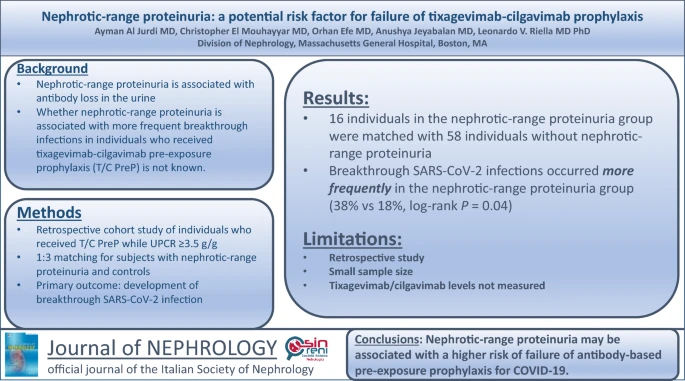Background: Pre-exposure prophylaxis with tixagevimab-cilgavimab has been shown to reduce the incidence of SARS-CoV-2 infection in immunocompromised individuals. Individuals with nephrotic-range proteinuria can lose immunoglobulins such as tixagevimab-cilgavimab in the urine and, therefore, may derive less benefit from tixagevimab-cilgavimab. There are no published studies evaluating the association of nephrotic-range proteinuria with failure of tixagevimab-cilgavimab prophylaxis.
Methods: We conducted a retrospective observational cohort study of all individuals at our center who received tixagevimab-cilgavimab while they had nephrotic-range proteinuria. Each individual in the nephrotic group was matched 1:3 with controls who were matched for B cell depletion therapy in addition to the total dose and date of first tixagevimab-cilgavimab administration. The primary outcome was the development of breakthrough SARS-CoV-2 infection after receiving tixagevimab-cilgavimab.
Results: Sixteen patients received tixagevimab-cilgavimab between January 1st, 2022, and June 30th, 2022, at a time when they had nephrotic-range proteinuria. Proteinuria levels and serum creatinine levels were higher while serum albumin levels were lower in the nephrotic group compared to the control group. At a median follow-up of 251 days, 38% of individuals in the nephrotic group had developed breakthrough SARS-CoV-2 infections, compared to only 13% in the control group at a median follow-up of 238 days. Nephrotic-range proteinuria was associated with a higher incidence of breakthrough infection (log-rank P = 0.04).
Conclusions: Nephrotic-range proteinuria may increase the risk of failure of tixagevimab-cilgavimab pre-exposure prophylaxis. Prospective studies to validate these findings and to evaluate the optimal dosing strategy of antibody-based prophylaxis in this group of patients are needed.

